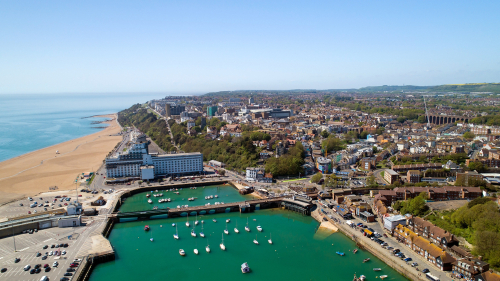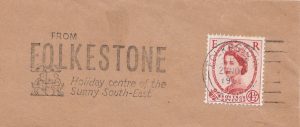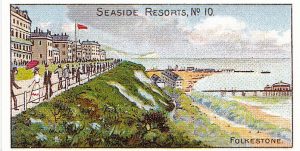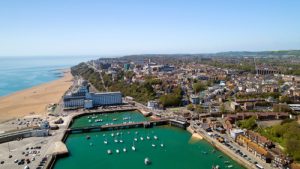
Folkestone is a Kent port town and tourist destination situated on the English Channel. It is a great place for a staycation being on the southern edge of the Kent Downs and within easy reach of both Dover and Canterbury. It was always regarded as a ferry town but since 1994, Folkestone has also been the location of the terminus of the Channel Tunnel. Once regarded as the holiday centre of the South East it remains a great place to visit given its long history and wealth of attractions. Speaking of which let’s start our guide with a bit of Folkestone history…

Folkestone A Quick History Lesson
Archaeologists have found evidence of human habitation in the Folkstone area dating to the Middle Stone Age, some 5,000 to 15,000 years ago. The Celts were the next to inhabit the south-east region of England, arriving as early as 2,000 BC from Central Europe. Artefacts have been found from their Iron Age settlement on Folkstone’s eastern headland. The mid-first century invasion of Britain by the Romans saw them take over the former Celtic clifftop settlement at East Wear Bay. It was there they built a villa, thought most likely to have housed a military unit involved in coastal defence.
When the Roman’s withdrew from Britain in the early 5th century they were in turn replaced by the conquering Anglo-Saxons. By AD 500, Folkstone was firmly established as part of the Saxon Kingdom of Kent. In 630 AD, Eadbald, the King of Kent, chose Folkestone as the place to found a church and nunnery, dedicate to St Peter and St Paul. He also built a castle for the protection of the nunnery, which was the main catalyst to the establishment of the fishing village of Folkstone.
The Middle Ages
In the mid-11th century, Goodwin, Earl of Essex, began a series of attacks on religious establishments in Kent, after a fall-out with Edward the Confessor. Folkestone became the target of one such attack and its church and nunnery were destroyed. By the time of the Norman invasion of England in 1066, the Manor of Folkestone was in the ownership of the Archbishop of Canterbury. However, after William became king he took the barony and gifted it to his half brother, Bishop Odo. By 1086, the Barony of ‘Fulchestan’, as it was named in the Domesday Book, was held by William D’Arcy.
In the ‘Domesday’ survey, the Manor of Folkstone was described as being some 6240 acres, with 5 churches and approximately 600 residents, with a value of £100. In 1095, Nigel de Muneville became Folkstone’s new lord of the manor. He founded a new church in the town and established a Benedictine priory close to the site of the old nunnery. In 1138, William D’Averanches, the ruling baron, rebuilt the parish church, dedicating it to St. Mary and St. Eanswythe.
King John Takes Up Residency
In 1213, King John made his headquarters in Folkestone as he prepared to defend an anticipated invasion by the King Philip of France. The Pope ordered the invasion in response to King John’s refusal to accept Rome’s nomination for the Archbishop of Canterbury. The main assault came in 1216, seeing much of the town and it’s church destroyed. Though, by 1220, restoration work had largely been completed. By 1299, Folkestone had become an associate member of the confederation of Cinque Ports, acting as a ‘limb’ to Dover. The main trade through the port was the export of wool, and the import of lavish goods, especially wine and luxury textiles.
In 1313, Folkestone received a charter from King Edward II, giving it the right to a mayor, a bailiff and 12 jurats (town officials). However, despite its new found status, Folkestone did not grow significantly. This was mainly due to the fact it had neither a river nor a deep water harbour, and thus, limited its development as a port. Even by the late 15th century, the start of the Tudor period, Folkestone’s population was still only about 500.
The Tudor & Stuart Era
Following Henry VIII’s Dissolution of the Monasteries Act of 1536, Folkestone Priory was demolished, its stone being used to build Sandgate Castle. The castle was built as part of a strengthening programme of the South coast’s defence. The stronghold is needed to repel the anticipated French invasion following Henry’s break with the Catholic Church. Part of the defence plans included extensive development of Folkestone’s port. And, though Henry himself made a point of coming to Folkestone to inspect the site, nothing was ever to come of the proposal.
In 1573, more royalty came to Folkestone. Queen Elizabeth I met with the town’s Mayor and Jurats on her way to Dover. In 1587, she came back to Folkestone to inspect the town’s coastal defences. England was once again under the threat of invasion, only this time from the Spanish. Folkestone was made subject to special taxes to contribute to the country’s war chest.
In 1674, Folkestone’s first school was established for children from poor families. The ‘free’ school and catered for some twenty boys who were taught to read and write in English and Latin. It was established by Sir Eliab Harvey, through a bequest of his Uncle Dr William Harvey, an influential physician and one of the town’s most famed sons. The school later became known as the Harvey Grammar School and continues in the town to this day.
The 18th & 19th Centuries
By the turn of the 18th century, fishing was established as one of the town’s main industries. However, another industry that began in the early 1700s and would dominate the local economy for well over a century was that of smuggling. It started off with the illicit export of wool to the continent. However, within a few short years it had grown to include the import of contraband, such as spirits, tea, tobacco, silk and lace.
Smuggling soon became a way of life for many of the Folkestone residents, which had plenty of local support. In one famous incident of 4 May 1820, eleven Folkestone men were caught smuggling red-handed. They were placed in custody in Dover jail by the authorities. However, the very same night, a fired-up mob from Folkestone descended on Dover with one purpose in mind. They stormed the jail and released their captive kinfolk, who subsequently managed to evade recapture.
In 1804, Lord Radnor petitioned Parliament for permission to build a stone harbour at Folkstone. In 1807, an Act of Parliament granted approval for the construction to go ahead. Up to this point, the anchorage at Folkestone had proved problematic due to shipping being exposed to strong tides, winds, and shifting sands. The Folkestone Harbour Company, established to develop the harbour, completed the Western Pier in 1810, and the second pier in 1820. However, the company eventually ran into financial problems as the harbour continued to silt up, and thus, subsequently declared bankrupt in 1842.
Railway Prominence
The harbour was then purchased by the South Eastern Railway Company who had a plan to develop Folkestone as a rival ferry port to Dover. The newly constructed railway line from London reached Folkestone in 1843. A harbour branch line was completed soon afterwards. The arrival of the railway managed to transform the failing harbour into a successful cross-channel port. Large and luxurious hotels soon sprang up along the seafront. Other facilities expect of a seaside resort, such as a pleasure pier, bathing establishments, theatres etc, were also quickly built during the 1880s.
The turn of events was significant in spurring the town’s population growth. In 1851, it had reached 6,726, almost doubling that from the previous 20 years. And, the trend continued, such that by 1881, it had soared to 18,986. By Edwardian times, Folkestone was established as one of England’s most fashionable coastal towns and seaside resorts.

The War Years
During WWI, Folkestone’s port became an important asset to the country’s war effort. It’s estimated that up to 10 million military personnel passed through the town during the four year conflict. Additionally, large numbers of refugees fleeing Europe, particularly from Belgium, also arrived in Folkstone from 1914 onwards. Consequently, the town’s strategic importance and proximity to Europe made it a target for aerial bombing raids by enemy Zeppelin airships.
On 25th May 1917, Folkstone became a target once again for the first-ever bombing raid on British soil by aeroplane. A German Gotha bomber dropped a single device on Tontine Street. It turned out to be the town’s most devastating attack of the war, killing 63 people. Some 78% of all the fatalities suffered from the raid of that day on the East Kent coast
Post-war, Folkestone underwent a good deal of rebuilding and refurbishment. A new marina, pavilion and pleasure gardens were all built, with a plan to transform the town to a popular holiday resort.
At the very beginning of WW2, thousands of school children were evacuated to Folkestone. However, it soon became apparent that the town would not be a safe haven as it was soon subject to heavy enemy shelling and bombing. Within a few weeks, the evacuees as well as 35,000 residents had left the town, which was effectively locked down. During the course of the war, the town would endure a total of 77 aerial bombings and 6 attacks from V1-flying bombs. In total, 123 civilians were killed and 778 were injured during the conflict throughout the Folkestone area. Some 550 properties were also destroyed and more than 14,000 sustained damage.
Modern Folkestone

Image Credit: Altitude Drone/Shutterstock.com
In 1946, the cross-channel passenger services to Boulogne and Calais were resumed but traffic was to gradually decline in the following years. Folkestone Harbour, and the ferry company, Sealink, were sold as part of the Government’s privatisation programme in the 1980s. New private owners soon found they were not able to compete with competition on other ferry routes, and from 1994, the opening of the Channel Tunnel. In 2000, the abolition of duty-free shopping was the final nail in the coffin for Folkestone as a ferry port, since passenger numbers began to plummet. By 2001, all ferry services to and from Folkstone had ceased.
Today, Folkstone’s economy is heavily influenced by its major transport links i.e. the Channel Tunnel to Calais, France, and the M20 motorway to London. The associated tourist and retail sectors provide the main sources of employment in the town. In 2019, an official estimate of the population of Folkstone was 53,949.
In recent years Folkstone has pushed to become a recognised as a centre for the arts and culture. Annual event taking place in the town, include the ‘Folkestone Book Festival’, taking place every November. The Comic Convention takes place each May, attracting more than 7,000 people to the town. The Hellfire Film Festival is a global multi-venue event that takes throughout the year, dedicated to independently made horror films. The Folkstone event usually taking place in Autumn. The Cheriton Light Festival takes place at the end of February and there is also Charivari Day, a street parade that takes place in July.
Getting to Folkestone
By Car
Getting to Folkestone from most of the country by car is straightforward. Just head towards London and then take the M25 circular road. From the M25, turn off for the M20, which will take you all the way to Folkestone.
By Coach
National Express operates a regular coach service from London Victoria Coach Station to Folkestone. The 65-mile journey usual takes a little over 2 hours.
By Train
Getting to get to Folkestone from most of the country will mean heading to London first. From there, you can take the high-speed South-eastern train from London St Pancras International, which takes a little under an hour. There are also normal speed direct services from Charing Cross, London Victoria and St Pancras, which take around 1 hour 40 minutes.
By Air
The nearest airport to Folkestone is Southend Airport, about 40 miles away, but it has a very limited flight schedule. London City Airport is about 56 miles and has flights to/from domestic and European destinations only. The nearest major international airport is London Gatwick which is around 60 miles away.
By Boat
There are regular ferry services to Dover from Calais and Dunkirk. Dover to Folkestone is only 8 miles along the A20. There’s a frequent bus service between the two towns.
Did you know?
- It’s thought Folkestone’s name was derived from a combination of the Old English word ‘stān’, meaning ‘stone’, and the personal name ‘Folca’.
- ‘Folca’s stone’ is thought to have been a marker of the meeting place for Folkestone’s ancient inhabitants. However, nothing is actually known of Folca, nor, where his stone had once stood.
- Folkestone is one of the sunniest places in the UK. The town averages around 2000 hours of sunshine per year.
- Folkstone was the home of England’s first known nunnery founded by Eadbald, King of Kent, in 630 AD.
- Folkestone is twinned with 5 towns around the world: Boulogne-sur-Mer & Étaples-sur-Merin in France; Middelburg in the Netherlands; Tres de Febrero in Argentina; and Mechinagar in Nepal.
Notable Folkestone People
- William Harvey (1578 – 1657) – was an English physician who made significant contributions to the understanding of human anatomy and physiology. He is credited with being the first person to describe and document the workings of the human heart and blood circulation system in detail. Born in Folkestone on 1 April 1578, it’s also where Harvey completed his early schooling.
- Josephine Edwina Jaques (1922 – 1980) – was a comedy actress of stage, screen and radio. A prolific television and radio performer, she was universally known by her stage name of ‘Hattie’ Jaques. Arguably, she is best remembered for her numerous appearances in the British ‘Carry On’ film series of the 1960s and 70s. She was born at 125 High Street, Sandgate, Folkestone on 7 February 1922.
- Gerald Sinstadt – is a legendary football commentator, broadcaster, and newspaper columnist. His career started in the 1950s and lasted for more than 50 years. He was born in Folkstone on 19 February 1930 and attended the town’s William Harvey Grammar School.
- Marcus Simon Sarjeant – achieved instant infamy on 13 June 1981. That’s when he fired six blank shots at Queen Elizabeth II as she rode down The Mall at the Trooping the Colour ceremony. Prosecuted under the Treason Act of 1842, Sarjeant was jailed on 14 September 1981 and served 3 years of a 5-year sentence. He grew up in Capel-le-Ferne, near Folkestone, and went on to attended Dover’s Astor Secondary School.
Sport In Folkstone
Folkestone Invicta FC
Folkestone Invicta FC currently plays in the Isthmian League Premier Division. Nicknamed ‘Invicta’, ‘The Seasiders’, or ‘Stripes’, the club plays its home games at Cheriton Road.
Folkestone Rugby Club
Folkestone RUFC currently plays in the London and South East League 4. They play their home games at the New Burlington Ground.
Folkestone Cricket Club
Folkestone CC currently competes in the 1st division of the Kent Cricket League. They play home matches at the Three Hills Sports Park, which is also a centre for hockey and netball.
Things to see in Folkstone
There’s a good selection of things to see in Folkestone. Here are a few recommendations:
- Elham Valley Railway Museum at Newington – loads of steam engines & an old-fashioned signal box makes this an ideal day out for any train buff. However, it also has a model of the Channel Tunnel, gardens and a local history exhibition.
- Folkstone Library Museum and Art Gallery – houses various displays that tell the story of Folkestone. There are also hands-on exhibitions and archive film. The adjacent gallery has a variety of art exhibitions and there’s also a heritage research room. An on-site café serves drinks and light snacks.
- Battle of Britain Museum at RAF Hawkinge – Has loads of original WWII item son display including wreckage parts from the Battle of Britain.
- The Leas Lift – is a grade II listed funicular (cable-driven) railway that carries passengers between the seafront and the promenade. Dating from 1885, the weight of water is used as a counterbalance to power the lift. It’s one of the oldest such lifts in the UK. It stopped functioning in 2017 due to high running costs but is currently under restoration.
- The Foord Valley Railway Viaduct – carries the HS1 railway line across the Foord Valley towards London. The imposing 100-ft high, brick-arch viaduct is one of the world’s highest such structures. Built it 1843, it towers over Folkestone as a monument to Victorian engineering and remains one of the South Eastern Railway’s most impressive bridges.
- Folkstone Museum – shares the Guildhall space with the Tourist Information Centre. The museum presents the town’s long history in five main themes: Fashion, Frontline, Maritime, Natural and Ancient. Dinosaurs, the Romans, shipwrecks, smuggling, fishing and other themes are all covered by the refurbished museum, which only re-opened in 2017.
Things to do Nearby
A few suggested things to do in and around Folkestone are:
- Sandgate Beach – is a relatively small though award-winning beach, just 1.5 miles from the centre of Folkestone. Water sports such as kayaking, wind sailing and rowing can be enjoyed in and out of season. You’ll find showers, public toilets, shops, cafes and pubs, all close at hand.
- East Cliff and Warren Country Park – is situated just east of the harbour. It’s a 300-acre park that consists of cliffs, beaches and a naturally terraced landscape known as ‘The Warren’. The Site of Special Scientific Interest has some 150 species of bird that can be spotted at various times throughout the year.
- Romney, Hythe and Dymchurch Railway (RH&DR) – is a miniature, light railway with a 15-inch track gauge. Almost all of the rolling stock dates to the 1920s and 30s. There are 6 stations on the 14 mile route which passes through some of Kent’s most scenic countryside. For the real enthusiast, there’s a ‘Drive a Steam Engine’ course, on a half-day, 1-day or 2-day basis.
- The Royal Military Canal – runs from Folkstone to Cliff End near Hastings. Built as a defensive barrier during the Napoleonic Wars, it was completed in 1809. While today, it provides a picturesque, mostly flat, 28-mile scenic walking route.
- Folkestone Creative Quarter – is home to an eclectic mix of galleries, artists’ studios, performance spaces, shops, cafes and restaurants. The Quarterhouse venue also hosts live music, film screenings, comedy and plays.
Where to stay in Folkestone
Inn, B&B and guesthouse style accommodation form the most available type of accommodation in and around Folkestone. A broad price guide for an overnight stay in the town for 2 adults sharing is:
Inn/B & B/Guesthouse/Lodge/Hotel: £40 – £90
Luxury Hotel: £90 – £150
Thinking of moving To Folkestone?
Are you thinking of moving to Folkestone? Over the last 12 months, properties in Folkstone have fetched an overall average price of £266,700. The best selling properties in the last year were terraced houses, selling for an average price of £229,000. Flats sold for an average of £193,000, semi-detached properties for £285,000, with detached properties fetching £478,200. Overall, the average property in Folkstone in the last 12 months, sold for 8% more than in the previous year.
So there you have it our Five Minute Overview of Folkestone and a quick quiz to see if you were paying attention! Before you go why not try some of our other quizzes or have a look at some of our other location guides. better still why not join our growing community it’s free and could be very rewarding going forward.


